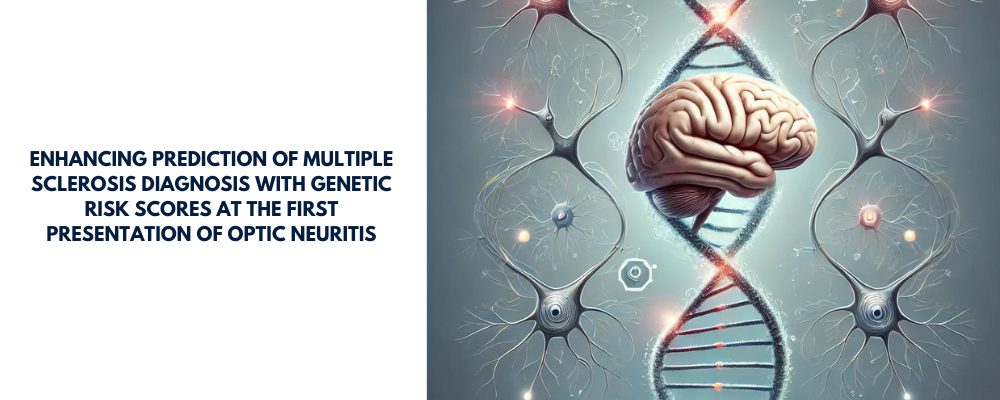Enhancing Prediction of Multiple Sclerosis Diagnosis with Genetic Risk Scores at the First Presentation of Optic Neuritis

Multiple sclerosis (MS) is a complex, neurodegenerative disease that affects the central nervous system, often following an initial episode of optic neuritis (ON). ON, characterized by inflammation of the optic nerve leading to vision loss, is commonly observed in patients who later develop MS. However, differentiating between optic neuritis that will progress to MS (MS-ON) and non-MS optic neuritis (non-MS ON) remains a critical clinical challenge.
A recent study published in Nature Communications explores the potential of using genetic risk scores (GRS) to predict the likelihood of MS diagnosis at the first presentation of ON. The study, titled "Applying a genetic risk score model to enhance prediction of future multiple sclerosis diagnosis at first presentation with optic neuritis", evaluates whether integrating MS-associated genetic risk with demographic factors, such as age and sex, can improve early diagnosis and treatment outcomes for MS.
Optic Neuritis as a Precursor to Multiple Sclerosis
Optic neuritis is often the first clinical sign of multiple sclerosis, with about 50% of ON cases progressing to MS within 15 years. The ability to predict which patients are at higher risk of MS is crucial, as those with MS-ON may benefit from early initiation of disease-modifying therapies, while non-MS ON cases may require urgent immunosuppression to preserve vision.
The researchers analyzed data from the United Kingdom Biobank (UKBB), involving over 483,000 participants, to develop and validate a predictive model that incorporates an MS genetic risk score (MS-GRS). This GRS was calculated based on genome-wide association studies (GWAS), which identified over 200 genetic loci associated with MS. The study aimed to determine if this genetic information, when combined with demographic factors, could accurately predict future MS diagnosis in patients presenting with ON.
The Role of MS Genetic Risk Scores
The MS-GRS used in the study aggregates the risk from multiple genetic variants, including both human leukocyte antigen (HLA) and non-HLA loci. The authors found that patients with higher MS-GRS were significantly more likely to develop MS following an ON episode. Specifically, one standard deviation increase in MS-GRS was associated with a 1.3-fold increase in the hazard of MS development.
To assess the model's effectiveness, the researchers stratified patients into quartiles based on their predicted MS risk. The results showed that the likelihood of MS diagnosis varied dramatically across these quartiles, ranging from a 4% risk in the lowest quartile to a 41% risk in the highest quartile. This suggests that MS-GRS could serve as a valuable tool for clinicians to stratify patients based on their risk of future MS and guide early intervention strategies.
Validation in External Cohorts
To ensure the robustness of their findings, the research team validated the model in two independent cohorts: the Geisinger-Regeneron DiscovEHR collaboration in the USA and the FinnGen cohort in Finland. In both cohorts, the MS-GRS was a strong predictor of MS diagnosis among patients presenting with undifferentiated ON. The model's performance was consistent across different populations, reinforcing its potential utility in clinical practice.
Validation in External Cohorts
To ensure the robustness of their findings, the research team validated the model in two independent cohorts: the Geisinger-Regeneron DiscovEHR collaboration in the USA and the FinnGen cohort in Finland. In both cohorts, the MS-GRS was a strong predictor of MS diagnosis among patients presenting with undifferentiated ON. The model's performance was consistent across different populations, reinforcing its potential utility in clinical practice.
Implications for Clinical Practice
The study's findings have significant implications for the management of optic neuritis and MS. By incorporating genetic risk into clinical decision-making, clinicians can more accurately identify patients at high risk of developing MS and tailor treatment accordingly. For instance, patients with high MS-GRS might benefit from earlier initiation of disease-modifying therapies, while those at low genetic risk might be spared unnecessary treatments.
Additionally, the use of MS-GRS could improve the allocation of healthcare resources by identifying patients who require more intensive monitoring and follow-up. This precision-based approach could ultimately lead to better outcomes for patients and more efficient use of healthcare resources.
Limitations and Future Directions
While the study demonstrates the potential of MS-GRS in predicting future MS diagnosis, there are some limitations to consider. The primary analysis was conducted on individuals of European ancestry, and the performance of the MS-GRS in non-European populations remains unclear. The authors acknowledge this limitation and call for further research in more diverse populations to ensure the model's generalizability.
Moreover, the study did not incorporate certain clinical factors, such as Epstein-Barr virus serostatus or the presence of brain lesions on MRI, which are known to influence MS risk. Future studies may enhance the predictive power of the model by integrating these factors into the risk assessment.
Conclusion
The integration of genetic risk scores into clinical practice holds great promise for improving the prediction and management of multiple sclerosis. By combining MS-GRS with demographic factors such as age and sex, clinicians can more accurately identify patients at high risk of MS following an episode of optic neuritis. As precision medicine continues to evolve, tools like MS-GRS will play an increasingly important role in guiding individualized treatment strategies and improving patient outcomes.
Reference:
Loginovic, P., Wang, F., Li, J. et al. Applying a genetic risk score model to enhance prediction of future multiple sclerosis diagnosis at first presentation with optic neuritis. Nat Commun 15, 1415 (2024).
